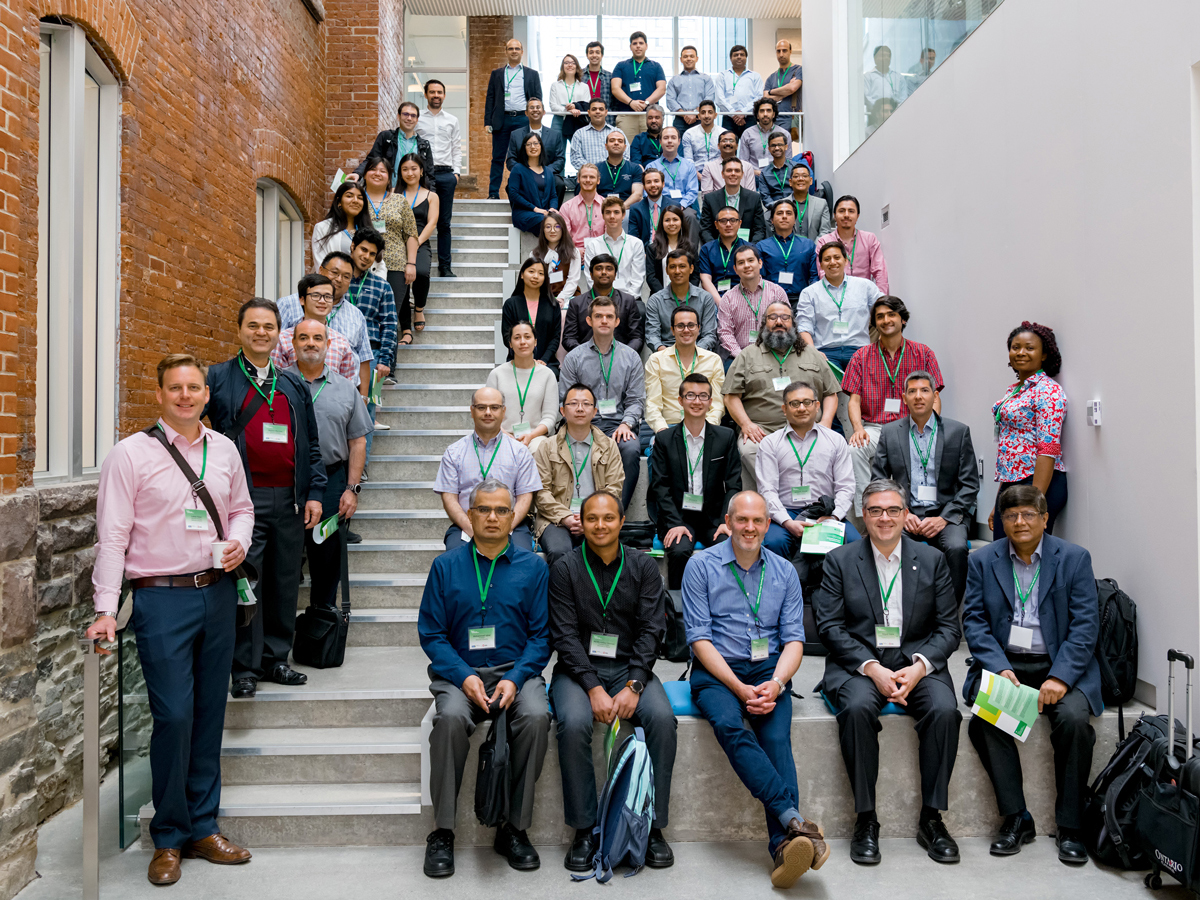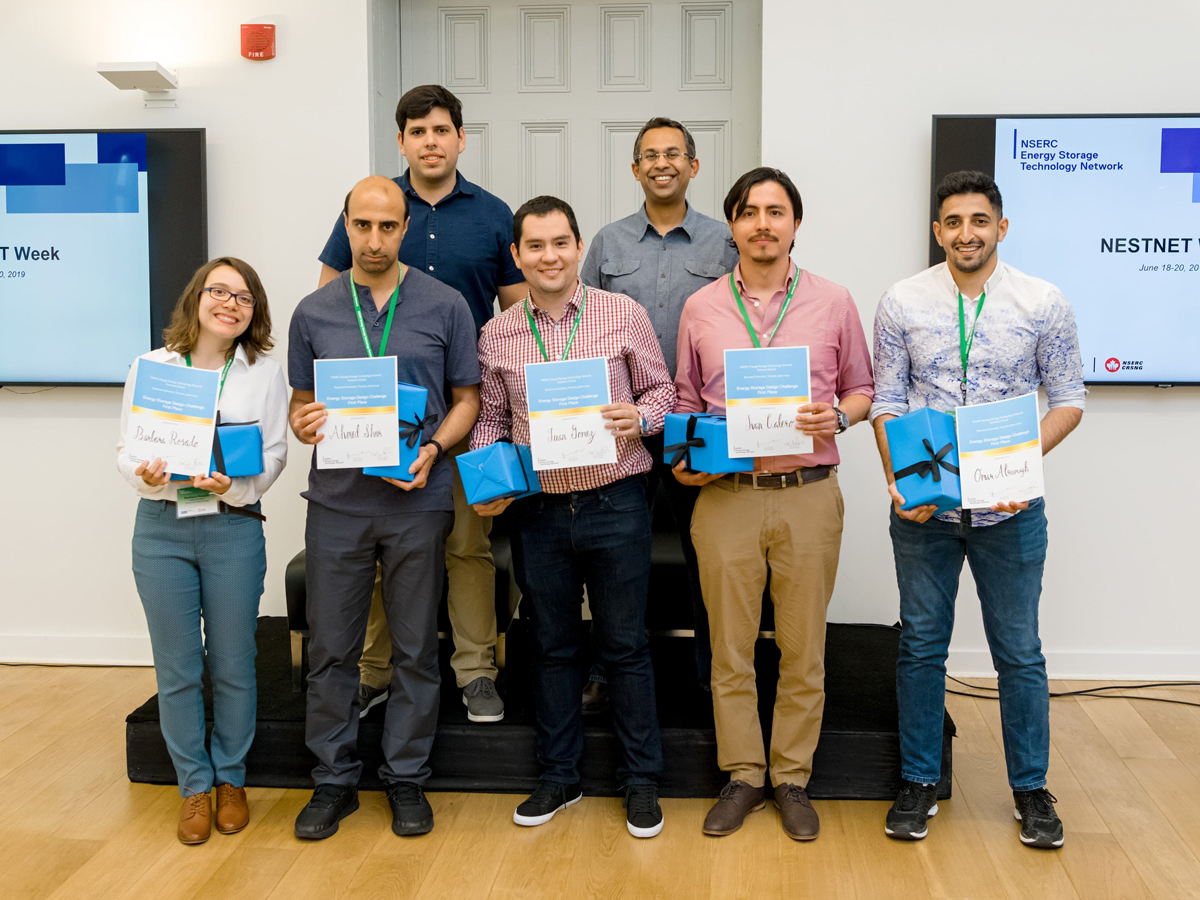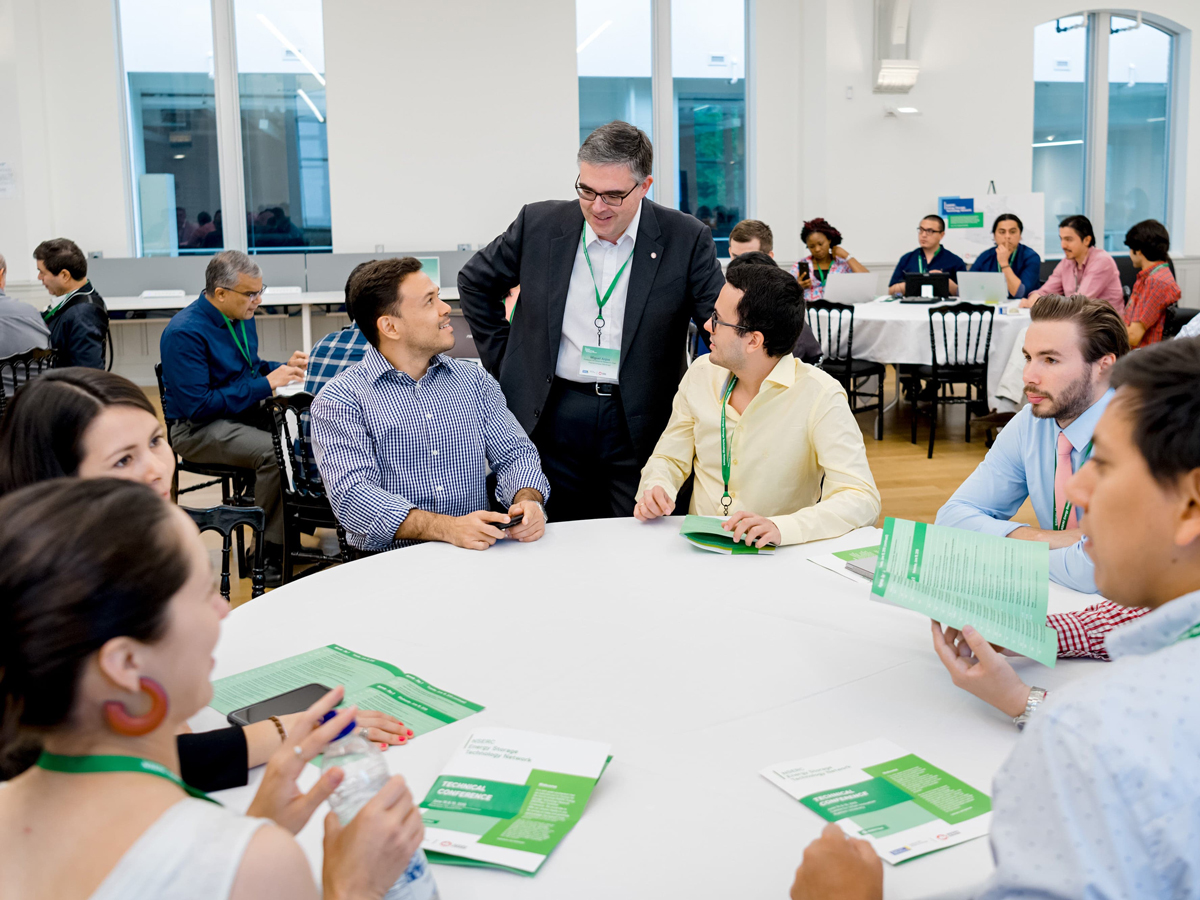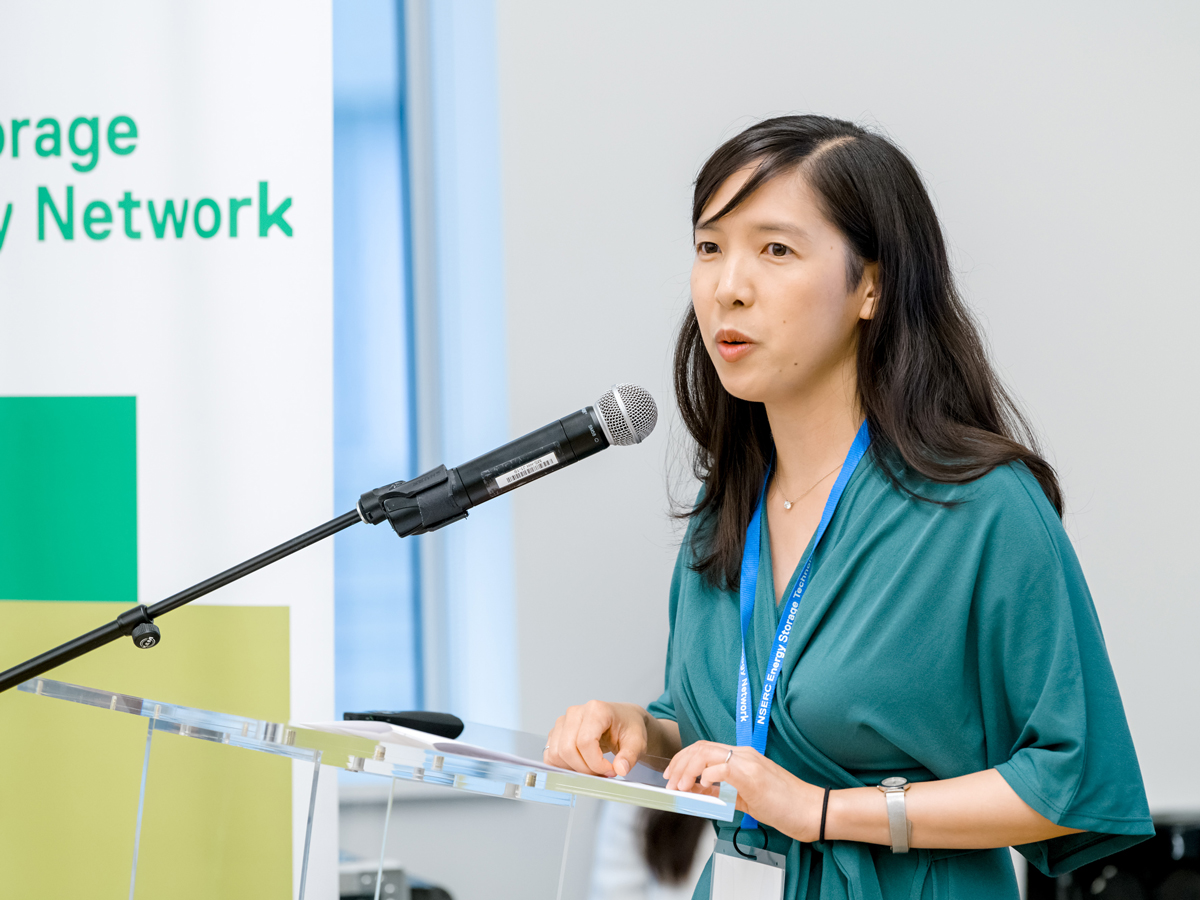Experts share knowledge on the future of energy storage at NESTNet Week 2019

NESTNet Week attendees gathered at the new Centre for Urban Innovation in Toronto.
The Centre for Urban Energy (CUE) and the Natural Sciences and Engineering Research Council of Canada (NSERC) hosted the fourth annual NSERC Energy Storage Technology Network (NESTNet) Week, engaging numerous researchers, industry and governmental members from across Canada, the United States, Brazil, United Kingdom and Germany.
From June 17 to 20, members of the network came together to collectively learn, collaborate and share knowledge with one another about the world of energy storage. The four-day event encompassed an all-day summer school open to students of the NSERC network, a two-day technical conference open to NESTNet members with themed presentations, and Leading the Charge Conference, a public stage for all energy stakeholders to share their perspectives on the future of energy storage.
Across campus, the Ryerson Image Centre was illuminated in green to mark the start and end of NESTNet Week, as well as to help inspire a clean energy future.
.@RyeLights is green in honor of #NESTNet week! It will continue to illuminate campus until our last conference day tomorrow! 🏙 pic.twitter.com/hXdx69cowK
— Centre for Urban Energy (@RyersonCUE) June 20, 2019
Day 1: Summer School

NESTNet Week energy storage design challenge winners. Front row (from left to right): Barbara Rosado, Ahmed Sheir, Juan Gomez, Ivan Calero, Omar Alrumayh. Back row: Carlos Sabillon, Bala Venkatesh.
The first day of NESTNet Week was filled with initiative and collaboration as five teams made up of students and postdoctoral fellows took part in a one-of-a-kind energy storage design challenge.
Bala Venkatesh, CUE’s academic director, kick-started the day before Carlos Sabillon, an IESO research fellow at CUE and facilitator for the day, hosted a discussion before the challenge got underway.
Sabillion explained that the objective for each team was to “design innovative solutions to present-day or near-future challenges in the energy sector.”
Each of the teams were expected to design and present a solution with one of many energy storage technologies, such as lithium-ion batteries and compressed air, and apply it to the energy sector. The challenge also encouraged them to reflect on multiple perspectives: technical, economic, environmental and social.
Throughout the day, teams strategized for their final presentations that would be delivered to a panel of judges from the energy sector: Bolis Ibrahim, CEO and founder of Argentum Electronics, Pratap Revuru, Senior Manager, IoT Solutions and Partnerships at Schneider Electric, Walmir Freitas, professor at the University of Campinas and Denis Tokarev, CEO and founder of Silk Way.
Chioma Anierobi, a master’s student in computer and electrical engineering from the University of Waterloo, said that she learned a lot from the challenge.
“When you find yourself in this kind of event, it is always a continuous cycle of learning from other people’s ideas,” she said.
Team 2, who focused on compressed-air energy storage, were ultimately the winners of the challenge and were presented their prize the next evening at NESTNet’s Technical Conference dinner.
“We put a lot of effort into our design proposals. It felt really good when it was announced that our team had won first place,” said Ivan Calero, member of the winning team and a PhD student in electrical and computer engineering at the University of Waterloo.
Calero added that the design challenge had been an interesting opportunity for students to work together under high-level pressure.
Reflecting on the presentations from all of the teams, Bolis said they all performed well given the time constraint but a couple of teams stood out.
“[Team 2] showed strength across every category: innovation, market potential, technical soundness and understanding of the legal, environmental and social context. They excelled. An honourable mention should also go to Team 3 [who focused on lithium-ion batteries], who came very close. I can’t wait for next year,” said Ibrahim.
Days 2 and 3: Technical Conference

Miguel Anjos, theme four leader and University of Edinburgh professor, speaks with researchers during the NESTNet Technical Conference.
The second and third day of NESTNet Week welcomed numerous professors from across Canada to downtown Toronto for a series of project presentations aligned with NESTNet’s four themes: energy storage, power electronics converters, power systems integration, and economics and policy.
Individuals in the audience were engaged throughout the day and were able to benefit from not only the knowledge shared during the presentations but from networking with other NESTNet members.
Dario Peralta, a PhD student electrical and electronics engineering at the University of Waterloo, said that one of the highlights from the conference was learning more about thermal energy storage.
“NESTNet has engaged us for the past four years to know the different sources of energy that we can benefit from. From small-scale to large-scale projects, how we can increase production in different areas,” said Peralta.
Likewise, Shuang Xu, a postdoctoral fellow at the Emera and NB Power Research Centre for Smart Grid Technologies at the University of New Brunswick, said that despite being in the field, he was surprised to learn new things about energy storage systems.
“The projects proposed [were] interesting and I think ... we could use them for changing the future of energy storage,” Xu said.
Day 4: Leading the Charge Conference

Jessie Ma, IESO research fellow, got proceedings underway at Leading the Charge Conference.
The fourth and final day of NESTNet Week was filled with notable speakers that captivated the audience with a diverse range of perspectives on energy storage.
The conference began with welcoming remarks from Jessie Ma, an IESO research fellow at CUE, which was followed shortly by the first keynote speaker, Jocelyn Millette, director of CanmetENERGY in Varennes, Quebec, one of three major federal research centres that focus on clean energy technology.
Millette said that the challenge is to keep electricity generation as clean as possible by integrating renewables and that is where energy storage comes into the picture.
“How can we shift the consumption to provide room for renewable energy into the grid? It has to be designed differently than what it was in the past to take the distributed energy resources into account,” he said.
In a panel session on energy for smart cities, Adrian Thomas, panelist and vice president of building at Schneider Electric, said that it is important to look at energy within the city “in terms of not just generating more efficiently but consuming more efficiently.”
“If we want to achieve really solid benefits of energy management, we can’t forget to look at the consumption of energy. If we’re going to achieve sustainability goals, we can only do that if we decrease our consumption of energy,” he said.
Some other notable speakers and panelists from the conference included Sören Hohmann, head of the Institute of Control Systems at Karlsruhe Institute of Technology, Shuvo Chowdhury, senior director of strategy at Amp, Harneet Panesar, director of strategy and integrated planning at Hydro One and Neetika Sathe, vice president of the Green Energy & Technology Centre at Alectra.
In a bid to accelerate commercialization of NESTNet’s projects, the final session provided a platform for researchers to bring their projects to the marketplace in partnership with industry attendees.
Moderated by Jennifer MacInnis, senior legal counsel and senior director of applied research and commercialization at Ryerson University, the presentations featured market-ready proposals from researchers. Highlights included:
- Ian Rowlands, associate vice-president, international at the University of Waterloo, discussed the creation of an online database of energy storage activity for the public. Rowlands said this would aid in public awareness, further dissemination of knowledge and would be an excellent research tool for industry members, students and the government.
- Miguel Anjos, professor and chair of operational research, school of mathematics at the University of Edinburgh, discussed a double façade model for thermal storage. Anjos said that in comparison to battery storage systems, this model would have a greater efficiency, be long-lasting and would naturally integrate into the building structure.
- Danica Sun, a masters of science candidate from the University of Alberta, discussed how flywheels can benefit the energy storage and how they can be used for potential vehicle technology and grid-scale applications.
- Ye Hua, a postdoctoral research fellow at the University at Ottawa, presented a proposal about adsorption based thermal energy for space heating and cooling applications. Hua said it could benefit the industry by filling up the technology and market gap of longer-term thermal energy storage products without storage time restraint.
- Behnam Tamimi, a postdoctoral fellow from the University of Waterloo, presented a modular energy storage-enhanced hybrid power flow controller designed to address the challenges of modern loads, such as EVs. Tamimi stated that the controller would improve system reliability and reduce costs by two-thirds versus controllers already on the market, as well as make use of refurbished grid components.
You can view photos from this year's NESTNet Week via Facebook (external link, opens in new window) .
NESTNet Week 2019 by the numbers:
168
attendees
5 countries represented
36
presenters
4th
year
30 cities represented
4
days
16 universities represented
3
events
Previous editions:
Madi Wong is a third-year journalism student at Ryerson University
"We put a lot of effort into our design proposals. It felt really good when it was announced that our team had won first place."